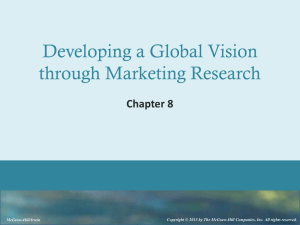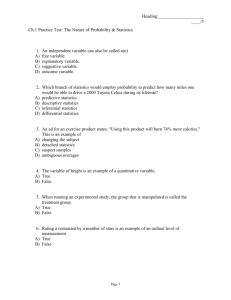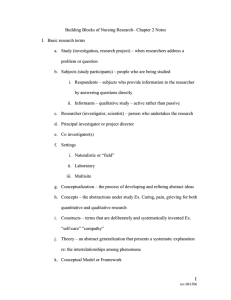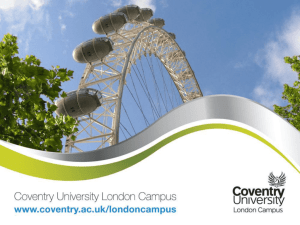Research Design and Methodology
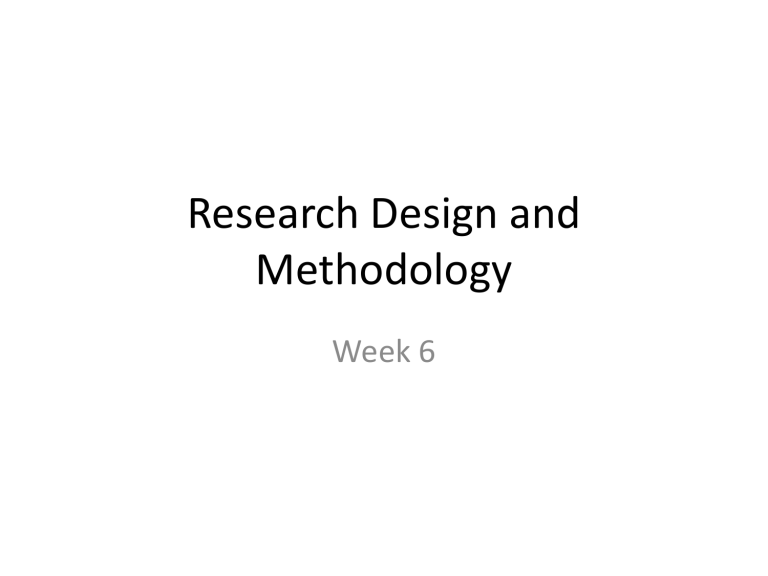
Research Design and
Methodology
Week 6
What have we done so far?
•
What is Research?
•
Clarifying your research
•
Literature Review
•
Research Paradigm
what’s the next step in the research process?
Research
Proposal
Formulate and Clarify the Research
Topic/Question
The Research Process adapted from: Saunders et al
(2007, pg. 10) , Cooper and
Schindler (2006, pg. 55)
Critically Review the Literature
Formulate your Research Design
Data Collection and Preparation
Address
Ethical
Issues
Data Analysis and Interpretation
Conclusion and Recommendation
Research
Report
What is Research Design?
•
Research design is the plan and the procedure for research that span decisions from:
–
Broad assumptions
–
to detailed methods of data collection and analysis
•
These decisions must be deliberated by the researcher and based on:
– the nature of the research problem or issue and
–
The researchers’ personal experiences
Theory
Influences on Research Design
Bryman (2008, p.24)
Practical
Consideration
Epistemology
Research
Design
Axiological-
Values
Ontology
•
Essentially, the research design answers three key questions:
1. What are the underlying assumptions,
2. How you are going to conduct the research, specifically the data collection and analysis and
3. Why this chosen plan would be best suited for the study. A justification of your choices.
The Research ‘Onion’
Saunders et al (2006)
Some clarifications on terms
•
Some say Research Paradigm (Lincoln & Guba
2000) Philosophy
(Saunder et al 2007)
or even
Worldview (
Creswell 2009)
•
Some use the term Research Methodology or
Research Strategy
•
Some say Research Methods or Technique or
Procedure
Key terms-definition
•
Research Paradigm -describes a cluster of beliefs and dictates what should be studied, how research should be done and how the results should be interpreted.
Bryman (2008, p.696)
•
Research Methodology - to emphasize an overall approach to the research process e.g. Survey or Action
Research
•
Research Method - used to outline a specific research technique or procedure for collecting and analyzing data e.g. Questionnaire or Focus Group
Purpose of Research Methodology
•
This is where you outline the primary data and secondary data needed for your research
•
It is the core research element of your project not the literature review
•
That is, how you get your data and process it to answer your research question
•
This means specifying :
– what data you need,
– where or who you will get the data from (your sample frame and sample)
PRIMARY DATA
DATA PROCESSING
TRANSFORMATION
Interpretation
•
Practical details on how you will collect the data, deciding what statistical or other processes you can use on the data
•
Deciding how to present the raw and processed data and
•
Finally checking that the collected data makes sense with what you intend to do
•
In summary think of your research design as a kind of function or transformation that takes your primary data and turns it into your desired project outcome , i.e. the answer to your RQ and objectives
What does it mean?
•
So your Research Methodology will specify the strategy that you will apply:
– in collecting the primary data
–
Transforming that data i.e. processing
–
Presenting and interpreting the results
•
The Research Methodology you specify will have a tremendous effect on your research outcome
•
One can understand why, if you collect the wrong data, using the wrong method then you will get the wrong result.
•
Thus you will not be able to provide any relevant or workable answer for your Research Question
•
You must also remember that the Research Paradigm you select underpins the Methodology chosen
Formulating a Scheme for Answering your Research Question
•
The scheme must arise out of the base problem and its cause
•
This scheme will provide an Idea for action
•
Try to think through whether your basic idea for action is about trying to:
–
explore and evaluate,
– describe and evaluate,
– understand and evaluate
Simple Example
Scenario:
•
Suppose that were trying to evaluate the website design effectiveness
•
What is needed is an idea of HOW to look for the results of the effective website design
•
So the first step is to get an idea for action
Idea settled on:
•
So we can look metrics of web usability such as :
•
Readability
• navigability
•
Accessibility
•
Website speed etc
•
It might be worthwhile to evaluate a number of websites
•
This is the basic idea
•
In practice you might try several ideas before you are happy with one
•
If you accept the idea you can NOW ask what data is needed
•
Without the idea for action it would be just guessing what the data might be required
Getting your Idea for Action
Time Horizon for your Research
•
Saunders et al (2009) articulates that time taken to research the phenomena is independent of which research methodology you have chosen or choice of research technique/method
•
There are two possible options:
–
Cross Sectional Studies
–
Longitudinal Studies
Cross Sectional Studies
•
These are designed to obtain information on variables in different context, but at the same time
•
Normally, different organizations or groups of people are selected and a study conducted to ascertain how factors differ
•
So it means, collecting data on more than one case at a single point of time. Bryman (2007, p.44)
•
For example, if you are investigating labour turnover
•
You will need to select a sample of work groups where you know that labour turnover is different
•
You can then conduct statistical test to find out whether there is any correlation between variables
•
Cross sectional studies are conducted when there are constraints of time or resources
•
The data is collected once, over a short period of time before it is analyzed and interpreted
•
Thus cross sectional studies take a snapshot of an on going situation
Longitudinal Studies
•
It is a study over time, of a variable or group of subjects
•
The aim is to research the dynamics of the problem
•
This is done by investigating the same situation or people several time or continuously, over the period in which the problem runs its course
•
Repeated observations are taken with the view to revealing the relative stability of the phenomena
•
This will allow the researcher to examine change processes
•
Therefore, it would be likely to suggest probable explanations from an examination of the process of change and pattern which emerge
Surveys Methodology
•
Typically indicated when the research question starts with ‘who’, ‘what’, ‘where’,
‘how’ many’ and ‘how much
•
It is therefore used for exploratory and descriptive research
•
This strategy provides a quantitative or numeric description of trends, attitudes or opinions
•
This leads to general inferences about a population from a sample of the population
•
The results will be very dependant on having a big enough and unbiased representative sample
•
You will have to use statistical techniques to demonstrate the likelihood that the sample would be characteristic of the population
•
You will have to specify the characteristics of the population and the sampling procedure and calculate the sample size
•
This is important because you would be making a set of generalized statements from your findings
•
You will have to name the survey instruments used to collect data
•
Critical to this strategy is the use of statistical processes to analyze the data collected
•
Usually you can make use of readily available software tools such as SPSS or even MS Excel
•
Indicative of a survey, is that the data you collect and analyze will be independent i.e. you have done it, not others
•
Surveys can be done using Cross Sectional or
Longitudinal studies
– i.e. data collected at one point or
–
Data collected over time
•
Data collection protocol or techniques can be wide ranging
–
Questionnaires
–
Interviews
–
Observations
–
Structured Record Reviews
Action Research
•
Typically indicated as useful when the research question starts with ‘how’
•
It is an approach which assumes the social world is constantly changing and the researcher and the research itself are part of this change
•
It is usual to conduct action research within a single organization
•
The research is concerned about the resolution of a business issue
•
There is a desire by the researcher to explain something and use that explanation to improve practice
•
That is, bringing about change in a partly controlled environment (your organization or workplace)
•
This requires the researcher to partner, collaborate and get involved with the client organization or practitioners
•
Therefore, the researcher is part of the organization where the research and change process is taking place
•
Be carful some action research may not be very far from a consultancy project or journalism
•
We do not want journalism at this level!
•
Stay away from political issues, social issues that you can just write 2000 words on, to solve a trivial problem
•
It is critical that the results of action research have implications beyond the direct subject i.e. your organization
•
In other words, the outcome of your research must be capable of being applied to other organizations or perhaps the industry as a whole or even other industries
Case Studies
•
Typically useful when research question starts with ‘Why’, ‘What’ and ‘How’
•
Case studies are commonly used to illustrate or understand a problem or indicate good practice
•
Therefore, Case Studies are often used in
Explanatory and Exploratory research
•
It is an extensive examination of a single instance of a phenomenon of interest
•
It focuses on understanding the dynamics present within a single setting, i.e. the context
•
Case study research must be constructed to the context in which management behaviour takes place
•
For most case studies there is usually be a longitudinal element
– that is the cases will run over a fixed time period
–
and you will periodically visit each case to collect the data
•
Case Study research can produce both quantitative and qualitative data
Organizing your Case
•
How many cases – be practical because there are time limits
•
Case Criteria - add as many criteria as you think necessary to pin down what will constitute a valid context but don’t have so many that you will never find a case that fits
•
Sample criteria – add as many criteria as you need to pin down a particular point from where data can be obtained and the sample size
•
Visit Frequency - each case must be visited to get the data so work this out by looking at how much total time is available for the study
•
Data collection Protocol – combination of observation, interview, document analysis. You will have to have a protocol to say when a valid sample size is attained
How many Cases or Types?
•
Single Case in this approach the researcher explores a single unit of analysis, i.e.
–
A company
–
A group of workers
–
An event
–
A process
•
Single Case can be:
–
Unique: implying that the setting and context are extremely rare and there may no be another chance to study this problem area again
–
Critical: implies an important theory that you want to test or a problem you want to solve and a particular case fits that profile
•
Multiple Cases-
– it means exploring more than one unit of analysis
– these may be desired over single case, in particular when you want to postulate a theoretical generalization between different units of analysis
Main Stages of Case Study Research
1. Selecting your Case- a representative case or a set of cases
2. Preliminary Investigations- the process of becoming familiar with the context, however keep your mind free of any bias
3. The Data Stage- determine how, where and when to collect data. Best to combine methods, known as Triangulation
4. The Analysis Stage-
– the analysis can be Holistic i.e. the entire case or
Embedded i.e. a specific aspect of the case
–
Through data collection a detailed description of the case emerges
–
The researcher might focus on a few key issues i.e. analysis of themes
For Multiple Cases:
–
Within-case analysis : here you would be building up descriptions whether quantitative or qualitative of one or each case, so that you can identify trends, patterns with the hope of pinning down a theory or phenomena
–
Cross-case analysis : here you may wish to identify:
• similarities , which would help to show whether your theory can be generalized or
• differences , which would help to extend or modify any theory.
•
Essentially, both will help you identify some common patterns
Useful Links
•
University of Chicago http://www.norc.org/projects/General+Social
+Survey.htm
•
University of Surrey http://sru.soc.surrey.ac.uk/
•
British Panel Household Survey http://www.iser.essex.ac.uk/survey/bhps
•
Social Research Methods http://socialresearchmethods.net/
Next Week
•
Research Techniques
–
Data collection
•
Questionnaires
•
Interviews
•
Observation
•
Focus Groups
–
Data Analysis
•
Analyzing Quantitative Data
•
Analyzing Qualitative Data
Bibliography
•
Collis. J,, Hussey R (2003) Business Research 2 nd edition, Palgarve Macmillan
•
Saunders, M., Lewis, P., Thornhill, A. (2009)
Research Methods for Business Students, 5 th edition, Prentice Hall
•
Creswell. J.W., (2009) Research Design,
Qualitative, Quantitative and Mixed Method
Approaches, 3 rd Edition, Sage Publications Inc.
•
Creswell.J.W., (2007) Qualitative Inquiry &
Research Design, Choosing Among Five
Approaches, 2 nd Edition, Sage Publications Inc.
•
Cooper, D.R., Schindler, P.S. (2006) Business
Research Methods, McGraw-Hill


